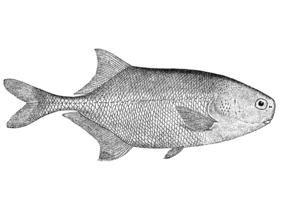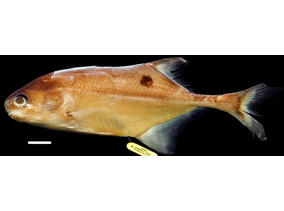You are here
Mormyridae
Petrocephalus sauvagii (Boulenger 1887)
Nomenclature
-
Subfamily: PetrocephalinaeGenus: Petrocephalus
SUMMARY
Petrocephalus sauvagii is one of the largest Petrocephalus species (maximum standard length = 189.0 mm, holotype = 146.7 mm). Body ovoid, body 2.7-3.0 longer than high (average = 3.0, holotype = 2.9) and laterally compressed. Head length between 3.5 and 3.7 times in standard length (average = 3.6, holotype = 3.7). Eye small (4.1 ≤ Head length/eye diameter ≤ 4.6, average = 4.3, holotype = 4.6). Snout very short and round. Mouth distinctively large (3.1 ≤ Head length/head width ≤ 3.7, average = 3.3, holotype = 3.1), sub–terminal opening just under the anterior half of the eye. Dentition consisting of many small bicuspid teeth, 24–30 (median = 26, holotype = 26) in a single row in the upper jaw, 30–34 (median = 32, holotype = 30) in a single row in the lower jaw. Dorsal and anal fins originate in the posterior half of the body (1.5 ≤ standard length/pre–dorsal distance ≤ 1.6 and 1.5 ≤ standard length/pre–anal distance ≤ 1.7). Pre–dorsal distance equal to, or slightly greater than, pre–anal distance. Anal fin with 33–38 branched rays (median = 35, holotype = 34). Dorsal fin with 26–30 branched rays (median = 28, holotype = 27). Scales cover the body, except for the head. Lateral line visible and complete with 36–41 (median = 39, holotype = 36) pored scales along its length. Twelve to 16 scales (median 14, holotype = 14) between the anterior base of the anal fin and the lateral line. Caudal peduncle relatively thin (2.3 ≤ caudal peduncle length/caudal peduncle distance ≤ 3.1, average = 2.6, holotype = 2.7). Twelve scales around the caudal peduncle. Skin on the head is thick, becoming opaque with formalin fixation, with Knollenorgan electroreceptors organized into three relatively small rosettes.
Body uniformly white–silver with metallic iridescence. Two characteristic melanin markings are present, sometimes with very weak intensity in large individuals: (1) an irregular round mark below the anterior base (first to fourth rays) of the dorsal fin; (2) an ovoid blackish mark, often irregular in shape, centered at the base of the caudal fin and extending onto the upper and lower fleshy lobes of this fin. The fins themselves (caudal fins and others) are translucent.






